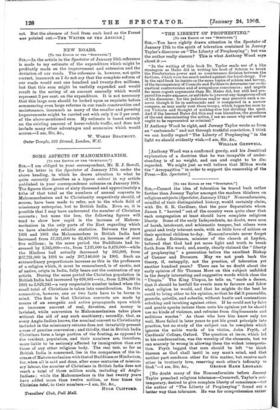NEW FOREST LIFE IN WINTER.
rTo THE EDITOR OP TEl "SPECTATOR."'
SIR,—The article on " New Forest Life in Winter " in your issue of January 3rd contained so many surprising statements regarding the life in our Forest that, failing a more authoritative pen, I venture to take up mine in its defence. Your contributor has judged the Forest out of a superficial knowledge of its ways and life, as is proved by such generalisatio as as that the Forest "is singularly devoid of life," and that "there is no sound but the sound of trees" in winter. It i s well known that birds are fewer in winter than in summer in woodland districts in England, because our summer vildtors have left and our winter visitors are less numerous. It is equally well known that birds are more silent—their notes are softer, shorter, and less frequent—in winter than in summer. Food is obviously scarcer in the winter months, and many of the birds are consequently more localised. So that, not. ithstanding the want of " cover "
the trees, birds are perhaps lets noticeable to the superficial observer in winter than in summer. Your contributor asserts that there are " almost no thrushes, few blackbirds and jays." Let him go to the holly bushes, which this year bear great crops of berries, and he will find there thrushes (missel-thrushes, song-thrashes, blackbirds, fieldfares, and redwings) innumerable. The jays are less noisy than in summer, and they are always shy and fond of thick places, but they seem as numerous as ever here winter and summer, notwithstanding the heads shown by the keepers. The tawny owls, which your contributor falls to find or hear, are nevertheless here in the winter in goodly numbers, and they are by no means silent. Moreover, their range in the winter is not restricted, as in some other birds, by the food supply. One wakes them from their daylight drowsiness as often in the winter as in the summer, and their soft-toned hoots from the woods seem more fitting to the melancholy of winter than to the liveliness of summer. As to the tits, which the writer of the article concluded were scarce owing to the supposed food which he found untouched, let him go quietly through the thicker woods and he will hear their call-notes softened by the hard life of winter. Let him raise his eyes to the tree-tops and he will see little flocks of tits—long-tailed, great, blue, coal, and marsh tits—and with them a few gold- crests, nuthatches, and creepers, keeping together for the pur- pose of more easily finding their food, and perhaps, too, for the sake of company.
Regarding the supposed scarcity of woodpeckers, I will say nothing of the two species of spotted woodpeckers, because they are inconspicuous compared to the green woodpecker. This woodpecker is especially conspicuous at this time of year, because it so often feeds upon the ground, while its form and flight and loud laughing note are too distinctive to be mis- taken. Green woodpeckers at all times of the year are as familiar to the forester as sparrows to the Londoner. There are practically no acorns or beechmast this year in the Forest, and consequently comparatively few wood-pigeons ; but had your contributor been here last winter even he would not have failed to notice the w ood-pigeons, for they were here in tens of thousands. I will not occupy your space, Sir, by referring to any of the numerous and interesting birds to be found in the New Forest in winter which are not so much as mentioned in the article in your issue of January 3rd.
The criticisms of the mammalian life of the Forest in winter are as unjust as those of the bird life. Rabbits are exceedingly numerous in parts of the Forest, as any " licensee" will tell the writer, and squirrels will show themselves to those who look, as the squirrel-hunter knows. As to the deer, it is true that they lie close in winter, but it is very rarely that one takes a walk without seeing them both inside and outside the plantations, and there is no need whatever to render them tame by providing a sanctuary. Tame deer can be seen in parks, but there are few places in England where fallow deer can be seen wild, and where they thrive through a continual fight for existence.
It were better that the writer of the article had made closer observations and gained wider experience before describing the life in the New Forest in winter.—I am,
[Residents in the New Forest are naturally jealous for its charms ; but compared with woodland districts elsewhere in England and in Hampshire, the Forest must be called singularly lifeless. In the small area of Wanstead Park, only some nine miles from London, and close to Epping Forest, there is generally a winter population of over a hundred wild duck, with moorhens and other waterfowL On one island in the lake is a heronry of about fifty nests, and a rookery adjacent of some five hundred nests. Rabbits swarmed all over Epping Forest until they had to be killed down. In the New Forest you may walk for miles without seeing one, though there are some local warrens. There are few or no hares ; the black-game have disappeared ; and in the open marshy ground very few peewits are seen, though they might naturally be expected there. There is no place in the Forest where any quantity of wildfowl can be seen, except at times a few on Hatchet Pond. Birds are well known to be more silent in winter than in summer, and they find less to eat. But the absence of food from such land as the Forest was pointed out.—THE WRITER OF THE ARTICLE.]







































 Previous page
Previous page